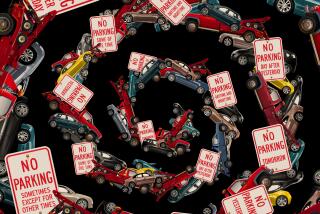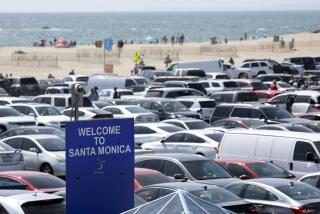Pricey parking could unclog city’s arteries
The first parking meter, invented by newspaper editor Carl C. Magee in 1935, was clad in metal and mounted on a pipe. Part slot machine, part alarm clock, it had to be wound by hand throughout the day. The charge: 5 cents an hour.
Within a year of its creation, the little device had pumped life into the moribund downtown business district of Oklahoma City, the first municipality to install Magee’s meters.
Ending the city’s free parking policy generated revenue, freed up spaces for shoppers and eased traffic congestion.
It’s a lesson in public policy that’s still relevant for today’s traffic-clogged cities, said Donald Shoup, an urban planning professor at UCLA and expert on parking.
To Shoup, free parking is behind much of what ails the modern metropolis. His research shows that inexpensive parking fosters urban decay, contributes to sprawl and motivates people to drive alone.
“We are always trying to get things for free, but all this freeloading is getting us into trouble,” said Shoup, who wrote “The High Cost of Free Parking,” the definitive book on the subject.
About 95% of commuters in the nation get free parking at work, and local governments regularly require businesses and developers of commercial buildings to provide free or inexpensive parking.
A 1990 study of five workplaces in Los Angeles and Ottawa, Canada, found that when employers eliminated free parking, the number of commuters who drove alone to the office dropped 41%. In the Bay Area, a survey taken in 2000 found that public transit was used 10 times more often by workers who did not have free parking than by those who did.
One tool available to companies is the little-known California “Cash Out Law.” But it has gone largely unused.
The law applies to leased parking spaces that are provided free to workers -- about 290,000 out of an estimated 11 million at workplaces statewide -- and requires employers to offer employees who opt not to use free parking the cash value of the space.
In 1997, Shoup studied eight employers in the L.A. area and found that their cash-out programs reduced driving to work by 13%. Transit use and carpooling increased among the 1,700 people who participated.
Low meter rates can further congest city streets as motorists search for cheap parkingspaces. Studies in New York indicate that motorists on the hunt represent about 28% of all traffic on Manhattan and 45% in Brooklyn.
In Los Angeles, Shoup and his students studied a 15-block area of Westwood Village, where street parking costs 50 cents an hour except during the evenings and Sundays, when it is free. They determined that searches for cheap curbside parking added about 2,500 vehicle trips a day in the area. The average search took about 3.3 minutes, but in the late afternoon and evening, searches took up to 12 minutes.
In contrast, decisions in 1993 to eliminate free curbside parking and set new time limits helped transform Old Town Pasadena over more than a decade from a blighted eyesore into an upscale destination with shops and restaurants.
In L.A., transportation officials are studying high-tech parking meters, pricing strategies and time restrictions.
“Downtown Los Angeles would thrive like Old Pasadena or San Diego if the city priced parking correctly,” Shoup said. “That is how we can begin changing the world” -- one parking place at a time.
--
dan.weikel@latimes.com



